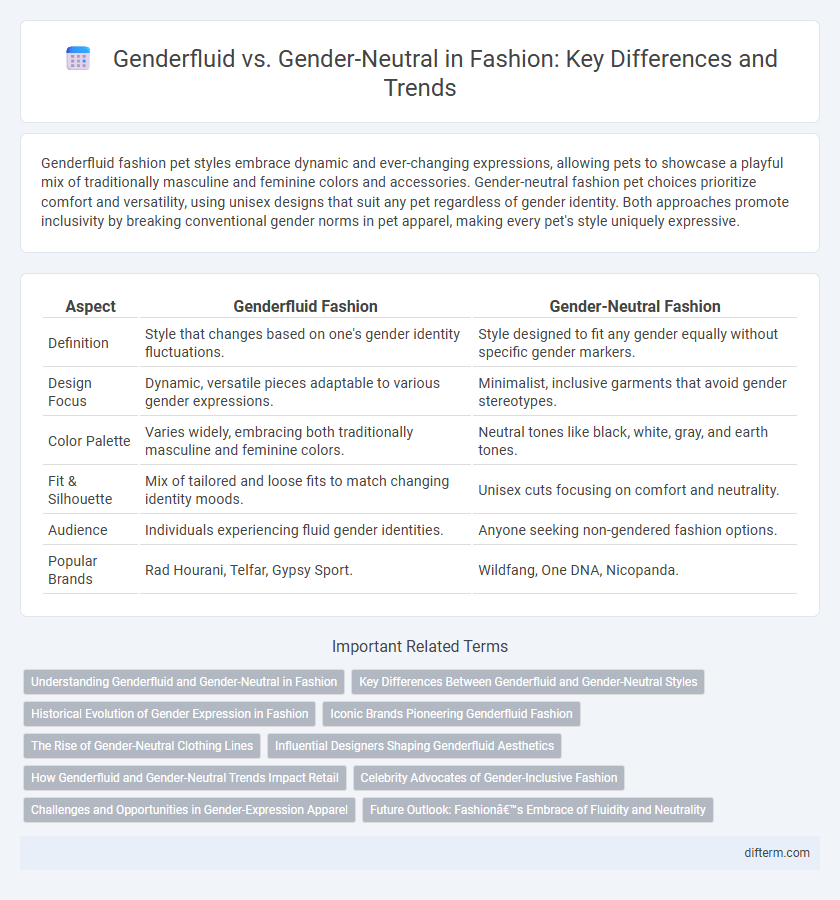Genderfluid fashion pet styles embrace dynamic and ever-changing expressions, allowing pets to showcase a playful mix of traditionally masculine and feminine colors and accessories. Gender-neutral fashion pet choices prioritize comfort and versatility, using unisex designs that suit any pet regardless of gender identity. Both approaches promote inclusivity by breaking conventional gender norms in pet apparel, making every pet's style uniquely expressive.
Table of Comparison
| Aspect | Genderfluid Fashion | Gender-Neutral Fashion |
|---|---|---|
| Definition | Style that changes based on one's gender identity fluctuations. | Style designed to fit any gender equally without specific gender markers. |
| Design Focus | Dynamic, versatile pieces adaptable to various gender expressions. | Minimalist, inclusive garments that avoid gender stereotypes. |
| Color Palette | Varies widely, embracing both traditionally masculine and feminine colors. | Neutral tones like black, white, gray, and earth tones. |
| Fit & Silhouette | Mix of tailored and loose fits to match changing identity moods. | Unisex cuts focusing on comfort and neutrality. |
| Audience | Individuals experiencing fluid gender identities. | Anyone seeking non-gendered fashion options. |
| Popular Brands | Rad Hourani, Telfar, Gypsy Sport. | Wildfang, One DNA, Nicopanda. |
Understanding Genderfluid and Gender-Neutral in Fashion
Genderfluid fashion embraces versatility, allowing individuals to shift styles and express varying gender identities through clothing that defies traditional male or female categories. Gender-neutral fashion prioritizes inclusivity by offering designs that avoid gender-specific aesthetics, focusing on comfort, practicality, and universal appeal. Both approaches challenge conventional fashion norms, promoting self-expression and diversity within the industry.
Key Differences Between Genderfluid and Gender-Neutral Styles
Genderfluid fashion embraces versatility with designs that can shift across masculine, feminine, and androgynous elements depending on mood or identity, emphasizing dynamic self-expression. Gender-neutral styles maintain a consistent, inclusive approach with clothing that avoids traditional gender norms, featuring unisex cuts, neutral colors, and universal fits to appeal to all genders. The key difference lies in genderfluid fashion's flexibility and changeability versus gender-neutral fashion's stable, non-binary aesthetic.
Historical Evolution of Gender Expression in Fashion
The historical evolution of gender expression in fashion reveals a complex interplay between societal norms and individual identity, with genderfluid styles showcasing fluidity and movement across traditional gender boundaries, while gender-neutral fashion emphasizes an absence of gender-specific markers. Early 20th-century designers like Coco Chanel challenged rigid gender norms by introducing masculine elements into women's clothing, paving the way for contemporary expressions of gender fluidity. In recent decades, fashion houses such as Gucci and Telfar have championed gender-neutral collections that prioritize inclusivity and reject binary constraints, reflecting broader cultural shifts toward non-binary and gender-diverse identities.
Iconic Brands Pioneering Genderfluid Fashion
Iconic brands pioneering genderfluid fashion include Gucci, who blend traditionally masculine and feminine styles into versatile collections that challenge binary norms. Telfar, known for its unisex bags and apparel, emphasizes inclusivity and self-expression beyond gender constraints. These brands use bold designs and marketing strategies to reshape fashion narratives, fostering a culture where fluidity and individuality take center stage.
The Rise of Gender-Neutral Clothing Lines
Gender-neutral clothing lines have surged in popularity, reflecting a growing demand for inclusive fashion that transcends traditional gender boundaries. Brands like Phluid Project and Telfar prioritize versatile designs that appeal to a broad spectrum of identities, emphasizing comfort and self-expression. This shift toward gender-fluid and gender-neutral apparel challenges conventional fashion norms, promoting diversity and acceptance within the industry.
Influential Designers Shaping Genderfluid Aesthetics
Influential designers like Harris Reed and Telfar Clemens are redefining fashion norms by creating collections that celebrate genderfluid aesthetics, emphasizing fluidity and self-expression through dynamic silhouettes and versatile fabrics. Reed's dramatic, gender-bending designs challenge traditional masculine and feminine codes, while Clemens's gender-neutral labels focus on inclusivity and accessibility, breaking barriers in mainstream fashion. These designers inspire a shift toward embracing diverse gender identities, showcasing how fashion can be a powerful tool for gender affirmation and cultural change.
How Genderfluid and Gender-Neutral Trends Impact Retail
Genderfluid and gender-neutral fashion trends are reshaping retail by expanding product offerings beyond traditional binary categories, encouraging inclusive sizing and design. Retailers are increasingly adopting unisex collections and marketing strategies that appeal to diverse gender identities, driving higher consumer engagement and brand loyalty. This shift promotes sustainability and innovation as brands create versatile pieces suitable for a broader range of customers.
Celebrity Advocates of Gender-Inclusive Fashion
Celebrity advocates of gender-inclusive fashion, such as Jaden Smith and Grace Jones, challenge traditional gender norms through their daring and eclectic styles. Their influence promotes genderfluid and gender-neutral clothing lines, emphasizing self-expression beyond the binary framework. These advocates drive the fashion industry towards embracing diverse identities, encouraging brands like Gucci and Telfar to create inclusive collections.
Challenges and Opportunities in Gender-Expression Apparel
Genderfluid apparel faces challenges in balancing versatility with clear stylistic cues, requiring adaptive designs that accommodate shifting identities without reinforcing stereotypes. Gender-neutral fashion offers opportunities for inclusivity by breaking traditional binary boundaries and promoting unisex silhouettes that appeal to diverse consumers. Both approaches demand innovative fabric technologies and culturally sensitive marketing strategies to resonate authentically with evolving gender expressions.
Future Outlook: Fashion’s Embrace of Fluidity and Neutrality
Fashion's future embraces fluidity and neutrality by dissolving traditional gender boundaries and promoting inclusive designs that cater to diverse identities. Brands and designers increasingly prioritize adaptive, versatile garments that reflect individual expression beyond binary norms. This shift fosters a dynamic market where genderfluid and gender-neutral styles drive innovation and redefine modern aesthetics.
genderfluid vs gender-neutral Infographic

 difterm.com
difterm.com